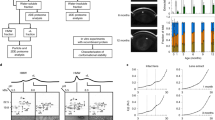Abstract
The specific activity of superoxide dismutase (SOD) in human transparent lenses declines as a function of age. Immunotitration using monospecific antibodies showed that, with increasing age, lenses exhibit an accumulation of catalytically inactive, but antigenically reactive, enzyme molecules. Antiserum produced against denatured enzyme removed the inactive molecules from the lens homogenates without affecting the enzyme activity. These aberrant molecules are at least partially denatured and are totally devoid of catalytic activity.
Similar content being viewed by others
References
Bhuyan KC, Bhuyan DK (1978) Superoxide dismutase of the eye. Biochim Biophys Acta 542:28–38
Crouch R, Priest DG, Duke EJ (1978) Superoxide dismutase activities in bovine ocular tissue. Exp Eye Res 27:503–509
Dovrat A, Gershon D (1981) Rat lens superoxide dismutase and glucose 6-phosphate dehydrogenase studies on the catalytic activity and the fate of enzyme antigen as a function of age. Exp Eye Res 33:651–661
Dovrat A, Gershon D (1983) Studies on the fate of aldolase molecules in the aging rat lens. Biochim Biophys Acta 757:164–167
Dovrat A, Scharf J, Gershon D (1984) Glyceraldehyde 3-phosphate dehydrogenase activity in rat and human lenses and the fate of enzyme molecules in the aging lens. Mech Ageing Dev 28: 187–191
Gershon D (1979) Current status of age related enzyme: Alternative mechanisms. Mech Ageing Dev 9:189–196
Gershon D, Reznick A, Reiss U (1979) Characterization and possible effects of age associated alternation of enzymes and proteins. Physiol Cell Biol Aging 8:21–26
Gershon H, Gershon D (1973) Inactive enzyme molecules in aging mice liver aldolase. Proc Natl Acad Sci USA 70:909–913
Glass GA, Lavie L, Dovrat A, Shpund S, Gershon D (1983) Further studies on SOD function and properties in different tissues of animals of various ages. In: Greenwald RA, Cohen G (eds) Oxy radicals and their scavenger systems, vol 2, Elsevier Science, Amsterdam Oxford New York, pp 1–10
Hanson H, Frohne M (1976) Crystalline leucine amino-peptidase from lens (aminoacyl-peptide dehydrogenase EC3.4.11.1). Methods Enzymol 45:504–519
Hockwin O, Hahn U, Swanson AA (1976) Studies on proteolytic activity in bovine lenses with aging. II. The endopeptidases, Ophthalmic Res 8:321–328
Lowry OH, Rosenbrough NJ, Farr AL, Randall RJ (1951) Protein measurement with the Folin phenol reagent. J Biol Chem 193:265–275
Marklund D, Marklund G (1974) Involvement of superoxide anion radical in auto-oxidation of pyrogallol. A convenient assay for superoxide dismutase. Eur J Biochem 47:469–474
Ohrloff C, Hockwin O (1984) Superoxide dismutase (SOD) in normal and cataractous human lenses. Graefe's Arch Clin Exp Ophthalmol 222:79–81
Ohrloff C, Bensch Y, Yaeger N, Hockwin O (1980) Immunologic detection of inactive enzyme molecules in aging lenses. Exp Eye Res 31:573–579
Ohrloff C, Hockwin O, Olsen R, Dickman S (1984) Glutathion peroxidase, glutathion reductase and superoxide dismutase in the aging lens Curr Eye Res 3:109–115
Pierie A (1968) Colour and solubility of protein in human cataracts. Invest Ophthalmol Vis Sci 7:634–650
Reiss U, Dovrat A, Gershon D (1980) Studies on superoxide dismutase function and properties in different tissues of animals of various ages. In: Bannister WH, Bannister JV (eds) Biological and clinical aspects of superoxide dismutase, vol B. Elsevier/North-Holland, New York Oxford, pp 286–291
Reznick AZ, Dovrat A, Rosenfelder L, Shpund S, Gershon D (1985) Defective enzyme molecules in cells of aging animals are partially denatured, totally inactive, normal degradation intermediates. In: Adelman RC (ed) Modification of protein during aging. Liss, New York
Towbin H, Staehelin T, Gordon Y (1979) Electrophoretic transfer of proteins from polyacrylamide gels to nitrocellulose sheets. Procedure and some applications. Proc Natl Acad Sci USA 76: 4350–4354
Van Heyningen R (1978) Lens neutral proteinase. Interdisc Top Gerontol 12:232–240
Author information
Authors and Affiliations
Rights and permissions
About this article
Cite this article
Scharf, J., Dovrat, A. & Gershon, D. Defective superoxide-dismutase molecules accumulate with age in human lenses. Graefe's Arch Clin Exp Ophthalmol 225, 133–136 (1987). https://doi.org/10.1007/BF02160345
Received:
Accepted:
Issue Date:
DOI: https://doi.org/10.1007/BF02160345




